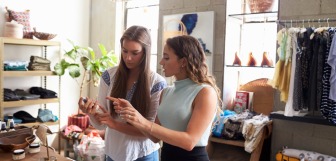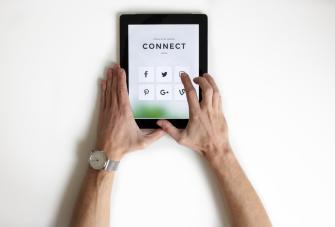5 Ways to Master Suggestive Selling in Your Shop
In the retail industry, the ability to make sales is a must-have skill. After all, shoppers are there to buy, and employees need to encourage customers to choose their products or services. But many people are turned off by the hard sales pitch and will avoid stores known for coming on too strong.
To improve customer satisfaction and increase sales, your store needs to master suggestive selling. You likely see this sales technique every day and never even notice it, which is why it works so well!
What is suggestive selling?
Suggestive selling is a sales method that typically involves an employee asking a customer if they would like to add a related product to their order. The additional products are often lower-cost complementary items that enhance the order.
For example, a shopper may buy a $400 phone, and the sales assistant can use suggestive selling to get the customer to add a $20 phone case and $10 protective screen.
This technique is a form of upselling and cross-selling, but it is not meant to be aggressive or pushy. Store associates suggest products that relate to the current items in the cart, making for a natural conversation with the customer.
Does suggestive selling work?
Yes. Yes. Yes.
The Wharton School of Business reports that half of shoppers want expert advice and most expect salespeople to have extensive product knowledge. Suggestive selling appeals to these desires by matching customers with relevant products based on getting to know them, and looking for ways to satisfy their needs.
It is also shown to bring in more sales. A study on suggestive selling found that it increased sales 16-18%, and upselling in general is known to boost revenue by 10-30% on average.
What are some benefits of implementing suggestive selling?
Aside from getting more sales, you will see that training your staff to follow this practice will improve customer experience, increase employee awareness, and encourage repeat visits.
Customer experience
How often have you had questions about a product but could not find an associate to provide answers?
While it may be annoying to hear, “Can I help you with anything?”, each time you enter a store, this engagement is critical. Training your sales staff to interact with customers will only make shopping at your store more worthwhile.
If you teach your staff to know the products inside and out and use suggestive selling wisely, customers will be happy to turn to you for advice. They will know that your store always offers superb customer service, helps them find the right product, and even recommends add-ons to make their purchase even better.
Employee awareness
A store associate cannot suggest products without knowing what the customer is buying and what they need. Executing this sales technique will require your employees to watch customers throughout the store and interact with them more frequently.

As your associates learn more about each customer and their buying needs, they’ll be more prepared for the next shopper to step through the door. It will eventually become relatively easy for staff members to suggest products they know performed well with past customers.
Not only will engagement increase, but your store might see less theft. Since your employees will observe customers and keep track of what they grab, they can discourage would-be shoplifters from stealing your goods.
Repeat visits
Returning shoppers spend 3x more on average than first-time buyers, and suggestive selling is a powerful tool to convert guests into repeat customers. Offering an outstanding experience from the first interaction is an investment that cannot be ignored.
More importantly, getting customers to return will help your business build a foundation of recurring revenue. As you become the monthly go-to shop for more and more customers, you will be more financially secure and can focus on large issues instead of day-to-day profitability.
Five suggestive selling techniques to you can implement
Be friendly
Train your staff to greet customers at the door and ask what they are looking for. While it may seem small, this simple interaction is found to increase retail sales.
Staff should not solely be looking to recommend products. Asking how the customer’s day is going can help break the ice and make the customer feel welcome. Even if they do not buy something during that visit, they will leave with a pleasant experience and may return later.
In some cases, shoppers may be hesitant to ask questions. By greeting each guest and starting a conversation, your employees can encourage guests to ask for recommendations and advice.
Group similar products
Although your floor plan probably follows this model already, review your inventory and see if you can group products that go together. Sometimes, these items are not similar by nature and may be in different aisles of the store.
For example, while it may make sense to place a wine opener in the kitchen supplies aisle, it is smart to include a small display of bottle openers near the wine aisle. When a shopper grabs a wine bottle, they will see the wine keys and corkscrews and possibly realise they need to buy one. Using this suggestive selling strategy does half the work for you since customers will take it upon themselves to get the add-on product.

If you have a speciality shop, such as a shoe or hardware store, it makes sense to keep small, must-have items near checkout areas. If a customer is buying a pair of suede shoes, you can recommend a suede cleaner sitting at the checkout counter.
Wait for the right moment
You cannot be pushy with customers and start recommending products without knowing what they need. Unless the guest asks for help after greeting them, back off and let them explore your store.
Once the shopper starts to pick up items or try things on, approach them again and ask probing questions. Find out what they are looking for, why they need it, or who will be using it. After establishing this rapport, suggestive selling becomes much easier.
Some guests may not want to talk, and that is totally fine. Your staff can always review their order at checkout and suggest complementary products. It is best to do this before sharing the total price with the guest, as they may not want to spend more after seeing how much they already owe.
Start a loyalty program
Suggestive selling does not have to end in the store. With a proper customer loyalty program, you can continue recommending products via email or text. Some stores even start the sales process immediately after purchase.
If a member of your loyalty program is known for buying a certain set of products, such as Apple products, your store can send out sales offers for related goods like Airpods. These targeted offers will encourage shoppers to return to your store.
This suggestive selling strategy doesn’t have to only happen in your store. Shoppers can capitalise on short-term deals by buying online, creating a multi-channel experience.
Choose the right point of sale system
Most importantly, your store needs to have the best retail management system. You need a POS that can accommodate your suggestive selling techniques and provide other features.
If you use a traditional POS, you will struggle to capture customer data or offer your guests a multi-channel experience. You need a cloud-based system that can sync with your online store and manage each aspect of your business.
With the Epos Now retail system, you get access to:
- Email marketing platforms like Mailchimp
- Loyalty integrations that create membership cards and reward repeat visits
- User-friendly software that makes checkout a breeze
- Dozens of apps, like Xero and Shopify, to help your business grow
- Accurate time-tracking records to simplify payroll
Schedule a demo with a POS consultant to see the power of Epos Now.




